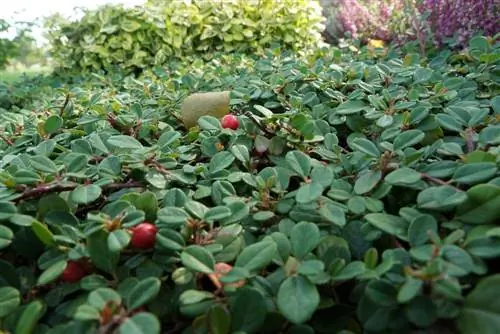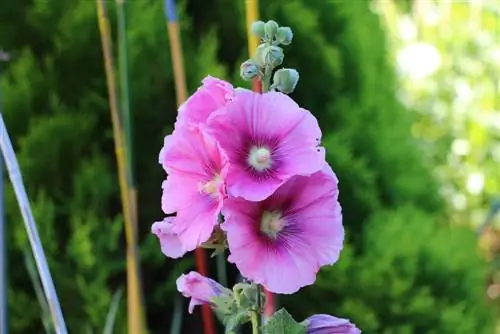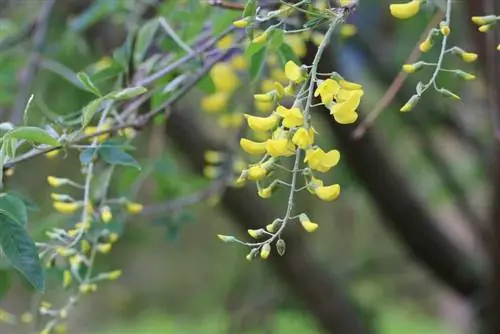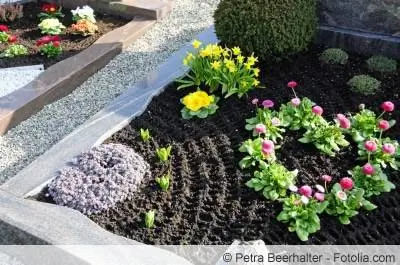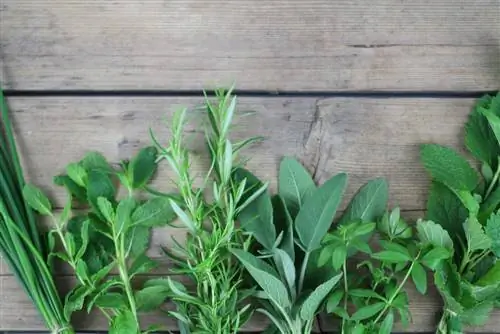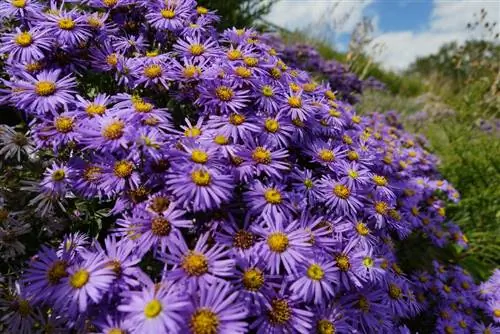- Author admin [email protected].
- Public 2023-12-17 03:39.
- Last modified 2025-01-24 12:45.
Slope planting should be well thought out, as the steep location often brings additional challenges in gardening. But with the right selection of the right plants for this demanding location, any slope can be turned into a visual eye-catcher. This article provides an overview of the most popular plants for growing on a sunny slope!
Which plants are suitable for planting on slopes?
The steep slopes usually mean that unpaved ground is washed away by the rain. In addition, the soil is usually very dry because rainwater has difficulty seeping away. Likewise, the amount of work is usually increased on a steep location, which is why permanent greenery is advisable. When choosing plants, it is important to consider the following:
- Plants with a pronounced root system
- these form well-branched and strong roots
- which can hold the ground
- Robust and vigorous plants are also ideal
Tip:
You should avoid growing plants with shallow roots on slopes. Because this means the risk of a landslide is too high. Likewise, plants that tend to become invasive should not be grown on slopes.
Groundcover
So-called ground cover plants are usually characterized by dense foliage and a decorative carpet of flowers. They form many runners and strong roots on the shoots and thereby hold the soil like a net. The ground cover also suppresses weeds and protects against erosion. The most popular ground cover plants include:
Spindle bush
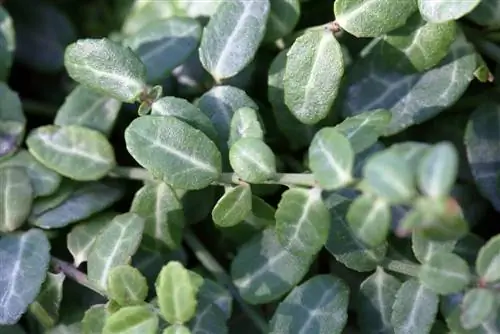
The spindle bush is suitable for sunny to partially shaded locations and can easily be grown on slopes. There are around 170 known species of this plant, with the “Minimus” variety being particularly suitable as a ground cover. The spindle bush does not tolerate waterlogging, which is why well-drained soil is essential for cultivation. The spindle bush is characterized by the following features:
- Latin name: Euonymus fortunei
- Synonyms: creeping spindle, spindle bush, climbing spindle
- Growth height: up to 3 m
- Foliage: green-white to green-yellow
- Flowers: white to pale green
- Fruits: pink to red capsule fruits
Shrubbill
The cranesbill impresses with its variety, as there are around 400 different varieties. It is also extremely easy to care for and usually tolerates dryness better than waterlogging. Therefore, the shrub beak is ideal for growing on a sunny slope. In addition to its strongly aromatic-smelling foliage, it also has the following features:
- Latin name: Geranium
- Synonyms: cranesbill, beakwort
- Growth height: 15 to 100 cm
- Foliage: green, yellow or red autumn color
- Flowers: cup-shaped, white, pink, violet, blue or carmine red
- Fruits: split fruits
Carpet St. John's Wort
The carpet St. John's wort prefers humus and nutrient-rich soil. Cultivation can take place on both a sunny and a shady slope. The plant is annual and perennial and is also very hardy. The carpet St. John's wort is also characterized by the following properties:
- Latin name: Hypericum calycinum
- Growth height: up to 30 cm
- Foliage: dark green or evergreen, elongated
- Flowers: cup-like and golden yellow
Cotoneaster
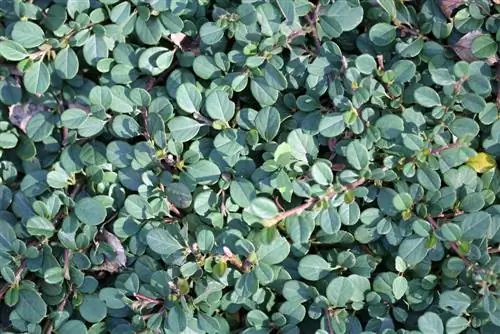
The cotoneaster spreads extremely quickly and suppresses any weeds. This makes it ideal for fastening embankments and slopes. The cotoneaster is frost hardy and easy to cut and also has the following properties:
- Latin name: Cotoneaster praecox
- Growth height: 15 to 20 cm
- Leaves: shiny dark green
- Flowers: white to pink
- Fruits: red apple fruits
Shrubs and trees
The cultivation of shrubs and trees is ideal for slopes, as the plants are usually very easy to care for. Regular pruning is usually not necessary for these plants, which makes the work required noticeably easier. The following shrubs and trees are suitable for growing on a sunny slope:
buddleia
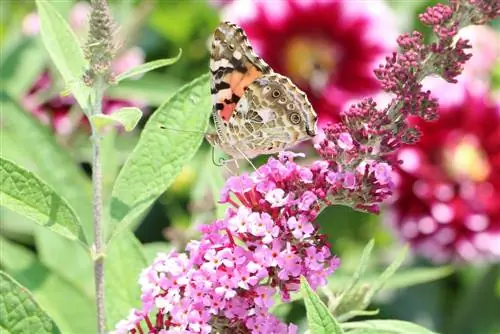
The buddleia not only impresses with its decorative appearance, but also exudes a very pleasant scent. The plant also magically attracts butterflies, which is why it is also known as “butterfly lilac”. The deciduous shrub prefers a sunny location and can easily be grown on slopes:
- Latin name: Buddleja davidii
- Synonyms: butterfly lilac, butterfly bush, lilac spear
- Growth height: 0.5 to 5 m
- Leaves: narrow-lanceolate, slightly toothed, dark green
- Flowers: many flower colors
- Fruits: capsule fruits
Privet

The privet is an evergreen hedge plant, which has around 50 species. It is considered very adaptable and is not picky when choosing soil. The plant tolerates drought without any problems, which is why the fast-growing plant is ideal for planting on slopes in a sunny location. The privet also has the following attributes:
- Latin name: Ligustrum
- Synonyms: rain willow
- Growth height: 2 to 5 m
- Foliage: evergreen
- Flowers: white panicles
- Fruits: poisonous berries or stone fruits
fingerbush
The finger bush grows sprawling, bushy and thrives best on moderately moist soils. However, it cannot tolerate drought because it is sensitive to drought and can die if it is dry for a long time. A location in full sun is ideal for this shrub, which blooms for months. The finger bush is also characterized by the following features:
- Latin name: Dasiphora fruticosa or Potentilla fruticosa
- Synonyms: shrub cinquefoil
- Growth height: 50 to 150 cm
- Foliage: summer green
- Flowers: cup-shaped, yellow, orange, pink, white, red
Ornamental quince
The ornamental quince is not only a visual eye-catcher, but also provides vitamin-rich fruits. It is considered completely undemanding and does not need to be cut. When choosing soil, make sure that it is not too calcareous. The ornamental quince also has the following properties:
- Latin name: Chaenomeles
- Growth height: up to 1.5 m
- Foliage: summer green
- Flowers: cup-shaped, red, pink, white or orange
- Fruits: mini quinces
creeping juniper
The creeping juniper is considered a particularly easy-care lawn replacement. It has no special demands on the floor and is also very robust and heat-resistant. Since it grows very slowly, cutting is not necessary. The creeping juniper also has the following attributes:
- Latin name: Juniperus horizontalis
- Synonyms: carpet juniper
- Growth height: up to 20 cm
- Foliage: very dense and cushion-like, steel blue, evergreen
- Fruits: small, blue-colored berry cones
Cornelian cherry
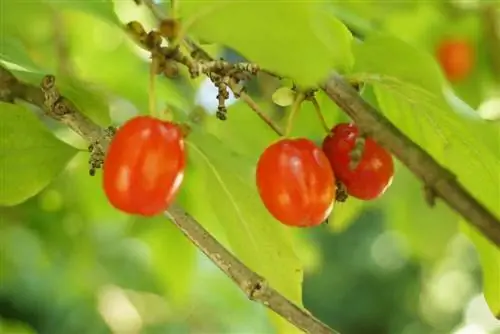
The slow-growing cornelian cherry is a robust, classic garden tree. Although it is considered quite undemanding, it does not tolerate waterlogging. When choosing the soil, make sure that it is moist, calcareous and nutrient-rich. However, the cornelian cherry also tolerates slightly acidic soils without any problems and also has the following properties:
- Latin name: Cornus mas
- Synonyms: Herlitze, Yellow Dogwood
- Growth height: up to 8 m as a tree
- Leaves: green, shiny underside of the leaves
- Flowers: yellow
- Fruits: red, cherry-like fruits
Wildflowers
Planting wildflowers is particularly popular due to their low maintenance requirements and decorative appearance. However, they are usually not suitable for growing on very steep slopes as they should be mowed at least once a year. The most popular wildflowers include:
Anthyllus
Anthyllis thrives ideally in sunny locations and prefers lime-rich and dry soil. The flower is not only a visual eye-catcher, but is also considered a medicinal plant. In addition, the anthyllus has the following properties:
- Latin name: Anthyllis vulneraria
- Synonyms: true anthyllus, common anthyllus, common anthyllus
- Growth height: 5 to 40 cm
- Leaves: pinnately pinnate
- Flowers: yellow with reddish tips
Carthusian Carnation
The chartreuse carnation prefers a well-drained, sandy soil in a full sun and dry location. It is considered a biennial plant and has good frost hardiness. The herb clove also has the following properties:
- Latin name: Dianthus carthusianorum
- Synonyms: stone carnation, stone algae
- Growth height: 10 to 60 cm
- Leaves: dark green, grass-like and pointed
- Flowers: purple
Cypress spurge
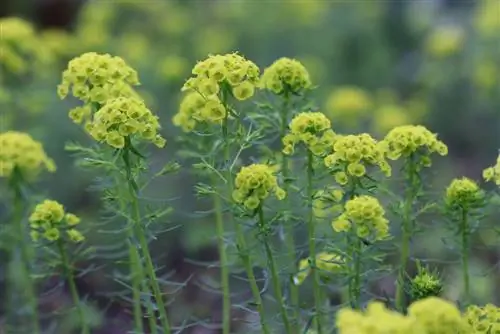
Cypress spurge is poisonous, but is also considered a medicinal plant. It prefers dry and well-drained soil. Although the plant spreads widely, it is not necessary to cut it back. Cypress spurge also has the following attributes:
- Latin name: Euphorbia cyparissias
- Growth height: 15 to 30 cm
- Leaves: blue-green to yellow-green
- Flowers: lemon yellow
Real bedstraw
The real bedstraw is a bright yellow wildflower whose flowers exude an intense honey smell. The bedstraw prefers a dry location and forms long and strongly branched roots. The real bedstraw also has the following features:
- Latin name: Galium verum
- Synonyms: yellow forest straw, lovewort, limbwort, Liebfrauenbettstroh
- Growth height: 20 to 70 cm
- Leaves: needle-shaped and furrowed
- Flowers: golden to lemon yellow
Ornamental grasses
The cultivation of ornamental grasses is particularly suitable on dry soils located south or west. They are considered easy to care for and are therefore particularly suitable for planting on steep slopes. The most popular ornamental grasses include:
Japanese blood grass
The Japanese blood grass is extremely warm-loving and therefore thrives best in sunny locations. When choosing soil, make sure that it is humus-rich and permeable. The Japanese blood grass is considered easy to care for and has the following characteristics:
- Latin name: Imperata cylindrica
- Synonyms: silver hair grass
- Growth height: 30 to 40 cm
- Coloring: bright red
Blue Fescue
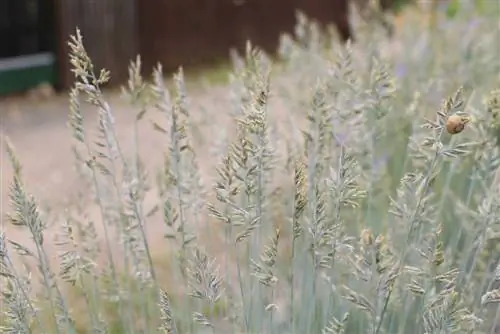
The blue fescue is considered extremely undemanding and can be grown on dry soils without any problems. It is also very easy to care for as it does not need to be mowed or trimmed. The blue fescue also has the following properties:
- Latin name: Festuca cinerea
- Synonyms: bearskin grass
- Growth height: 20 to 30 cm
- Color: blue-gray
Mosquito grass
The mosquito grass prefers dry and sunny locations. It also thrives best on permeable and calcareous soils. It also impresses with its unique appearance, as its flowers resemble well-known insects. The mosquito grass also has the following properties:
- Latin name: Bouteloua gracilis
- Growth height: 20 to 40 cm
- Coloring: blue-green
Conclusion
Sunny slopes can be beautified with a variety of plants. An interplay of different types of plants, such as wildflowers, ground cover and shrubs, is ideal. Many of these plants are also considered robust and easy to care for, which reduces the amount of work required to a minimum.

